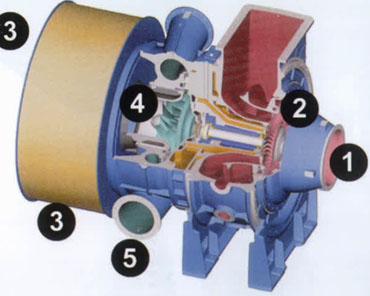Marine engine starting system. Marine engine exhaust gas. Combustion air
Marine engine starting system. Marine engine exhaust gas. Combustion air
Marine engine starting system
In order to start an internal combustion engine, as you know, it must be cranked several times so that the cylinders are filled with the working mixture, it compressed and ignited, pushing the pistons. The handle used to start old Soviet cars is not suitable for an engine the size of a house; you need something more powerful. On ships, compressed air is traditionally used for this, stored in cylinders at a pressure of 30 bar.

In this case, the main engines of low power or auxiliary engines can be started with the help of electric or pneumatic starting motors, powered by batteries or compressed air. For this, a battery charging system or a compressor for pumping air into the cylinders with the engine running must be provided. This starter motor cranks the engine by the toothed flywheel until it starts.
When the engine is started with compressed air, it is supplied to the cylinders through a separate camshaft-driven valve distributor in the same manner as when the engine is running. When the engine is cranking, fuel is injected and the air supply is cut off.
10 bar is usually sufficient for a start. However, the cylinders must have a pressure of 30 bar in order to start the engine several times if necessary.
Exhaust gas
The composition of the exhaust gases is a very hot mixture of carbon dioxide, water vapor, unburned fuel and lubricant, nitrogen oxide (a product of atmospheric nitrogen oxidation), sulfur dioxide (formed by the combustion of sulfur contained in the fuel) and carbon in the form of soot. Sulfur oxide reacts with water to form sulfuric acid, which eats away at the steel of the ship's exhaust pipes. By adjusting the engine operating cycle, it is obtained within certain limits to reduce the amount of harmful to the environment oxides of nitrogen and sulfur.
In some offshore areas, there are restrictions on the use of heavy fuel oils with a high sulfur content (1.5% instead of the usual 3.5%) by ships in order to reduce sulfur oxide emissions. The vessel is sometimes forced to switch to "cleaner" diesel fuel. There are also filter systems that reduce nitrogen oxide emissions, but they are quite expensive.
The heat from the exhaust gases can be recovered, for example, to heat fuel, heat water or heat the ship's premises. Otherwise, it will literally be thrown into the air. This function is performed by special heat exchangers on the exhaust pipes, called economizers.
The exhaust gases can heat a special heat transfer oil, or produce steam for shipboard use, usually for heating heavy fuel oils.
Despite the availability of such "free" heat sources, the ship should still have heaters independent of the main engine, providing heating and other needs of the ship when docked in port, or when the main engine is not running at full power.
Air for fuel combustion on board
Air is required for fuel combustion in the cylinders. It comes from the engine room, and outside fresh air is supplied there with the help of fans, cooling the room. But it's still very hot there. Therefore, in the navy, Russian mechanics and mechanics, hardened by a Russian steam bath, are valued.
Air is supplied to the cylinders with some excess in order to improve the combustion process and reduce the temperature of the exhaust gases.
 A pressurized combustion air supply can dramatically increase engine power, which is why a turbine with a heat exchanger is often used. It uses the kinetic energy of the exhaust gases to pre-compress the air, which, after cooling, enters the cylinders.
A pressurized combustion air supply can dramatically increase engine power, which is why a turbine with a heat exchanger is often used. It uses the kinetic energy of the exhaust gases to pre-compress the air, which, after cooling, enters the cylinders.
This is how air in different forms is used in ship power plants.
 +7 (812) 4-673-673
+7 (812) 4-673-673